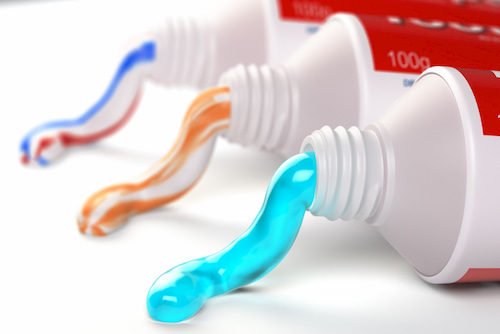
The Main Ingredient
Potassium nitrate is often the active, main ingredient in sensitivity toothpaste. This compound is able to seep into the surface of the enamel of your teeth, reaching the nerves inside. The potassium nitrate then blocks the signals that the nerves in your teeth usually send to the brain to trigger discomfort. Although the active ingredient in toothpaste for sensitive teeth is effective, it usually takes several uses of toothpaste before you can see and feel the difference.
Fluoride for Sensitive Teeth
Sensitive teeth toothpaste also contains fluoride, and although this well-known ingredient won’t block the pain, it does help strengthen the enamel of the teeth, keeping strong foods from reaching the nerves. It has the added benefit of reducing your risk for cavities, too. Along with using a toothpaste that contains fluoride, you might also consider having your dentist or hygienist apply fluoride gels or varnishes to your teeth during your semiannual checkup to further strengthen your enamel.
Your Product Options
A variety of toothpaste for sensitive teeth is available today: Maximum-strength toothpaste for tooth sensitivity usually contain 5 percent potassium nitrate. Although reducing sensitivity is the overall goal of a sensitive teeth toothpaste, it’s not the only goal; these toothpastes also provide cavity and tooth decay protection and help reduce tartar levels. Some products help whiten the teeth as well, using abrasives that are specially formulated to gently remove stains from the enamel’s surface. Other toothpastes are designed to be less abrasive, reducing erosion in the tooth’s enamel.
What Else You Can Do
Using a toothpaste made for sensitive teeth is just the beginning. The way you brush, what you eat, and how well you care for your teeth all play a part in helping to reduce sensitivity. For example, brushing with too much vigor or force can lead to erosion of the enamel. Try to brush more gently, using a soft-bristled toothbrush. Be gentle when you brush around your gums, too, to reduce the chance of them pulling away and exposing the roots of your teeth.
Eating certain foods can also weaken the enamel of your teeth, making sensitivity more likely. Sugary foods increase your risk for tooth decay, but acidic foods increase your risk for the erosion of the enamel and sensitive teeth. Sometimes, sugary foods are also acidic foods, such as soda and juice. Acidic foods also include citrus fruits, pickles, and apples – foods that are otherwise healthy.
One way to reduce your teeth’s exposure to this acid is to use a straw when drinking, and drink a glass of water while eating. Although it’s usually recommended that you brush right away after a meal, if you have a higher risk for enamel erosion, it’s often a good idea to wait about an hour before brushing. Acidic foods soften your enamel, and toothbrushing too soon after eating can abrade it further.
Your dentist can provide further assistance when it comes to treating your sensitive teeth. He can advise you on how long to use the toothpaste and what to do if it doesn’t provide the relief you’re after.
